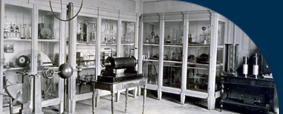This device, which is to be considered one of the first models of an electric motor supplied by continuous current, was projected and built in 1822 by the English mathematician and physicist Peter Barlow (1776-1862). The original model differed from Nobili's because it had a toothed wheel in the form of a star. Nobili gave the following description of this instrument: «This instrument consists of two parts and of an appendix. The two parts are: first, a small square wooden base, which has two cavities, one in the form of a cup and the other in the form of a container; second, a small brass wheel that can move between the arms of a double square, which bears it above the container. The appendix consists of a small horse shoe-shaped magnet mounted into a small base. In order to make the small wheel of the mill rotate, one proceeds in the following way. The container is filled with mercury up to the level of the wheel, which the mercury must barely touch. More mercury is poured into the second cavity, where the foot of the double square is fixed. Then the appendix is placed in such a way that the wheel can freely rotate between the arms of the two magnets. Those arms must pass slightly beyond the point in which the small wheel communicates with mercury. After having placed the device in this way, it is necessary to place the wheel into the voltaic circuit so that one of the connecting wires reaches the cup and the other the container. In the course of this last action the small wheel rotates according to the direction of the current (Barlow) »[Nobili 1834]. |
Questo dispositivo, che è da considerarsi tra i primissimi modelli di motore elettrico a corrente continua, fu ideato e costruito nel 1822 dal matematico e fisico inglese Peter Barlow (1776-1862). Il modello originale si differenziava da quello proposto dal Nobili per avere una ruota stellare. Nobili di questo pezzo fornì la seguente descrizione: «Questo pezzo è composto di due parti e d'un'appendice. Le parti sono, primo un zoccoletto quadrangolare di legno, che ha due incavi l'uno in forma di coppa, e l'altro in forma di vaschetta; secondo una rotella d'ottone mobile in mezzo alle branche d'una doppia squadra, che la sostiene sopra la vaschetta. L'appendice consiste in una piccola calamita a ferro di cavallo montata sopra un zoccoletto. Per far girare la rotella del molinello si opera nel seguente modo. Si riempie di mercurio la vaschetta sino all'altezza della rotella, che il mercurio dee toccare appena. Si riempie d'altro mercurio il secondo incavo, dove è fissato il piede della doppia squadra. Poscia si presenta l'appendice alla rotella in modo che quest'ultima possa liberamente girare fra le braccia delle due calmite. Queste braccia deggiono passare un poco al di là del luogo in cui la rotella comunica col mercurio. Disposto così l'apparecchio non resta cha a mettere la rotella nel circuito voltiano col far pescare uno de' fili congiuntivi nella coppa e l'altro nella vaschetta. All'atto di quest'ultima operazione la rotella si mette a girare per un verso o per l'altro secondo la direzione della corrente (Barlow)» |

